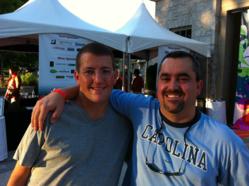Boston, MA / February 11, 2013
At the age of 28, Kevin Kirby was diagnosed with a disease that most people have never heard of. Called Facioscapulohumeral Muscular Dystrophy, or FSHD, the disorder is named for the body areas that are typically affected: the face (facio-), shoulder blades (scapula-) and upper arms (humeral). The disease weakens muscles in these regions, making it difficult to blink or smile, or raise the arms overhead. FSHD can also affect leg and hip muscles, leading to falls, broken bones and dependence on a scooter or wheelchair. The disease can also lead to hearing loss in some patients.
A former distance swimmer and three-time Junior Olympian, Kirby can no longer swim laps, so two summers ago he decided to put a swimming pool to a different use, as a party venue to raise funds for the FSH Society. The nonprofit Society has helped to build a global research effort to discover and develop a cure for this currently untreatable disease. The FSH Society co-authored the Muscular Dystrophy CARE Act, which mandates the Centers for Disease Control (CDC) to work on FSHD.
Around 500,000 people have FSHD worldwide. It is one of the most common muscular dystrophies, and between one and two percent of the general population carries a genetic risk factor linked to FSHD. While the public is familiar with Duchenne muscular dystrophy, a devastating disease affecting boys, muscular dystrophy is also a disabling and costly disease among adults. In order to spotlight adult dystrophies, the CDC is featuring Kirby’s story on its website this month.
Earlier this year, Kirby went on disability. But that did not slow him down. He keeps himself busy doing volunteer work for the Humane Society and AIDS vaccine development. And he wants to help patients newly diagnosed with FSHD. “It’s overwhelming to learn you have a disease you can’t even pronounce,” he says. “Social media is helping connect patients and break down the isolation faced by many with FSHD.”
Overcoming the need many patients feel to keep their disease private, Kirby decided to become a public advocate to raise awareness about FSHD. In the CDC feature story, Kirby shares how he tried to remain ambulatory, suffering many falls and trips to the emergency room until he was reconciled to using a wheelchair. He regrets having put himself through so much to avoid the chair. “Now I can do so much more,” he says.
To help public health officials understand the health care needs and quality of life of people with muscular dystrophy and their families, CDC supports and manages MD STARnet, the Muscular Dystrophy Surveillance, Tracking, and Research Network. MD STARnet has identified and studied every individual born with Duchenne and Becker muscular dystrophy since 1981 in six states. CDC is currently testing the feasibility of collecting information on the seven other muscular dystrophies including FSHD.
Working with the American Academy of Neurology (AAN), CDC is also backing the development of clinical guidelines for four types of muscular dystrophy: FSHD, myotonic dystrophy, limb-girdle muscular dystrophy and congenital muscular dystrophy. These guidelines will be published by the AAN in 2013. The FSH Society will be joining other muscular dystrophy organizations to make sure doctors and patients everywhere know about the guidelines.
FSH Society President and CEO Daniel Perez praises the CDC, saying “These are important initiatives to improve health outcomes and address health inequities for men, women and children with muscular dystrophy.”
Over the 22 years since its founding, the FSH Society has worked closely with federal agencies, researchers, advocacy organizations around the world, and patients like Kevin Kirby, to raise and direct millions of dollars towards research on FSHD. The investment is beginning to pay off with the discovery of the genetic causes of the disease in 2010 and 2012. Pharmaceutical companies have teamed up with academic institutions to hunt for potential treatments.
Kirby turned 40 recently and in the same month became the owner of a van. “I don’t think that’s how your midlife crisis is supposed to go,” he quipped. When asked if he thinks about the next ten years, Kirby says “I can’t stress about the things I can’t control. Today my life is great.”
Helpful Websites:
- CDC’s muscular dystrophy website
http://www.cdc.gov/ncbddd/musculardystrophy/index.html
- MD STARnet


Leave a Reply